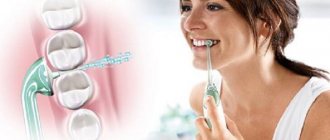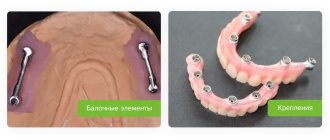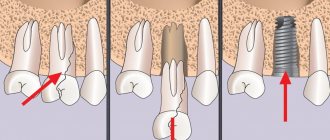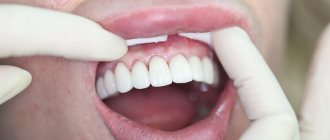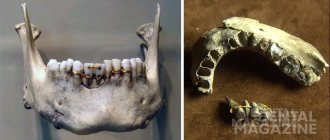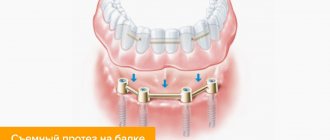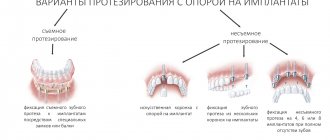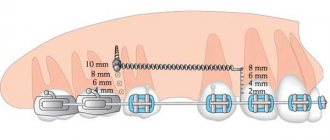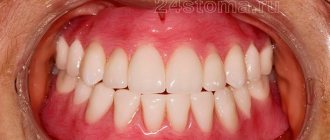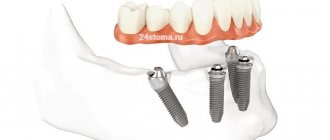Modern methods in dentistry, including the latest technologies in implantation, can solve almost any problem, including complete absence of teeth. However, installing a large number of implants entails large financial and time costs. It is not surprising that a system that requires only four implants and reduces surgical time can be considered the most optimal option for most patients. Dmitry Valerievich Levin, candidate of medical sciences, chief physician and implant surgeon of the Doctor Levin Center for Private Dentistry in Moscow, talks about the features of all-on-4 or “all on four” implantation.
What is All-on-4 implantation?
“All on four” implantation is the fixation of fixed dentures on four implants installed in the upper or lower jaw. The prosthesis is fixed on implants using special screws, which ensures good stabilization. Only a doctor can remove such a prosthesis; this usually happens twice a year - for inspection and necessary preventive measures. The patient’s attendance at such preventive examinations is strictly mandatory, as this prevents the development of possible complications.
Why you should contact us
Our clinic employs the best specialists with extensive experience in the field of All-on-4 implantation. We have the most modern equipment and our own laboratory. We use only original implants coming directly from Europe. All our doctors regularly undergo advanced training at institutes in the USA, Germany and Switzerland.
We are responsible for the work performed and the health of the patient. Contact us. We will try to make your life better.
What are the indications for All on Four dental implants?
One of the indicators can be the small volume of bone tissue in both the upper and lower jaws. It is especially problematic with the required volume of bone tissue for implantation in the chewing sections, since in the absence of teeth for quite a long time, the volume of bone tissue in these sections decreases, and this happens even when using removable dentures. In order to install the number of implants required for fixing fixed prostheses (from 6 to 10), a preliminary operation is required to restore the required bone volume. Only after this are implants installed, and after some time (from three to eight months) prosthetics are performed on them.
Is it possible to immediately install a removable or fixed or temporary prosthesis on an implant?
Before the implantation operation, a plastic prosthesis is made in the laboratory based on a pre-made impression, which, after minor modifications, is fixed on new supports. It is possible to immediately install an old removable denture, having previously prepared it in the laboratory, if the implantation operation is carried out in 2 stages. If a one-stage implantation with immediate loading was carried out, you can also use a previously prepared old removable denture. With this method, splinting of the supports is achieved and the load is evenly distributed between the implants.
How long does it take to install four implants?
The time spent on the implantation operation is no more than four hours. In difficult situations, when the volume of bone tissue is minimal, the patient is recommended to make an individual template. It is made based on a three-dimensional tomogram image. Before introducing all four new supports, the dentist determines the “front of work” and carries out planning in the appropriate program. He plans to insert implants into the jaw and the computer determines the possibility of this. The dental technician makes a template using a special machine and hands it over to the surgeon. Then, during the surgical procedure, the bed is formed in accordance with a pre-prepared template matrix, which has special guides and stops for the drill. Six months later, or in some cases four months later, the temporary prosthesis will be replaced with a permanent prosthesis.
Difficulties during the implantation procedure
Complications can occur during any surgical procedure, including innovative technologies. Immediately after surgery, inflammation may occur after the insertion of implants - early peri-implantitis. It should not be confused with postoperative swelling, which is present in most cases. In the case of ordinary edema, everything will return to normal in the future if the patient pays due attention to the care and doctor’s prescriptions. Inflammation of tissue near the implant - reimplanitis occurs when microbes of a pathogenic nature appear in the area of the implant and in the bone tissue that holds it. But such cases are rare, since the entire implantation procedure is aimed at eliminating such cases and the doctor does everything in his power to prevent re-implantitis. Modern implantology is impossible without powerful pharmacological support; the latest generation of highly effective drugs are used.
How to Care for Dentures Installed with the Inexpensive All-on-4 Method
Any denture, regardless of the type and principle of its operation, requires close attention. It is worth noting that it is recommended to take care of implants and dentures even more than healthy teeth. Hygiene requires much more time and effort, and care products require more advanced and expensive ones. The orthopedic design, which is installed on 4 supports, is no exception. Caring for fixed dentures does not differ from standard oral hygiene, but should also include an ultrasonic toothbrush and irrigator. To completely clean the denture, especially its internal parts, you will need to buy interdental periodontal brushes. It is recommended to clean the surface of the denture and the area around it using a special toothpaste for permanent dentures on inexpensive implants. It can be purchased at the pharmacy chain. If this is a conditionally removable denture, you need to regularly visit your dentist for control and professional hygiene.
Price for implantation using prosthetic technology on four supports
Unlike removable dentures, the use of innovative technologies costs several times more; on the other hand, the quality of life that the patient receives certainly justifies the intervention; it allows a person to get rid of social discomfort in the absence of teeth and restore his health.
The cost of the operation is not only the installation of the implant, but also the effect that the patient receives in return. The total cost of the prosthetic procedure on 4 implants is no more than 200,000 thousand rubles - turnkey. This will be an operation to install 4 implants and it will be a high-quality prosthesis. The patient can independently choose the construction material and type of prosthesis; the final cost of prosthetics will depend on his choice.
At the same time, you should familiarize yourself with all the risks of this operation. follow the link and read in more detail about the disadvantages of this technique
[email protected] Samara region, Samara, Industrial district affordable reliable dentistry st. Novo-Vokzalnaya, building 269 phone +7 (846) 990-88-56
meta information. Inexpensive implants, install implants inexpensively, affordable price of implantation, insert teeth inexpensively and reliably in Samara, which implants are inexpensive and reliable
What are the advantages of dental prosthetics with 4 implants?
If we compare the “All on Four” technique with the use of removable dentures, the difference will be that in the first case the risks of mucosal injury, bone loss, as well as difficulties with fixation and correction are reduced to zero.
A patient with a removable denture experiences discomfort both functionally and socially. Most people who use removable dentures experience some self-doubt, and sometimes even inferiority in their social status. Also, when installing “all on four” implants, as already mentioned, there is no need for a large number of implants. Due to the fact that these four implants are installed in certain positions in relation to each other: when implanting the front teeth - straight, and in the lateral teeth - at an angle of 35º to 45º, and also by creating a large distance between them, the chewing load is adequately distributed and is redistributed during operation. A small number of implants simplifies the operation, making it faster and more predictable, while ensuring excellent results.
Benefits of technology
The technique of jaw prosthetics on 4 implants is widespread. It formed the basis for numerous schemes that make it possible to restore the dentition in a wide variety of difficult cases. This is the fastest and most reliable way to improve the quality of life in edentulous (no teeth) patients.
We can only talk about the advantages of the procedure and the possibilities of its use in certain cases; it has no disadvantages as such. The main thing is that jaw implantation allows you to restore chewing function and even create a beautiful smile.
Among the main advantages are:
- Speed. The entire structure can be manufactured in just 2 days.
- Lifetime warranty. Implants are installed once for a lifetime. A removable denture can be replaced if necessary. Its standard warranty period is 5-7 years. However, there are no purely medical restrictions here. It all depends on the strength of the load. Practice shows that many patients wear the same design for decades without any complications or inconveniences. Replacement is required only in case of physical wear of the prosthesis.
- No specific contraindications. If there are inflammatory processes in the mouth, surgery is postponed, but this is not an absolute contraindication. Only a complete ban on surgical intervention can serve as a basis for refusing a patient a jaw implantation with 4 implants in our clinic. In the case of the presence of foci of osteoporosis, rare pathology, hypertonicity of the masticatory muscles, and significant atrophy of the jaw bone, the decision is made individually.
- Low invasiveness. The procedure is almost bloodless, which allows you to do everything in 2-3 days.
- Easy rehabilitation. Low morbidity allows the patient to quickly recover and begin a full life.
The All-on-4 turnkey implantation procedure is an excellent alternative to removable dentures. There is no reason to refuse it.
What types of prostheses are used when implanting All-on-4?
For “All on Four” implantation, fixed prostheses are always used, which, however, can be called conditionally removable, because they are fixed with special screws, but at the same time they are fixed rigidly. The patient is not able to remove them while wearing them; I repeat, this can only be done by a doctor for regular checks.
Designs of this type have stood the test of time, showing excellent clinical results. The reliability of work done using this technology is beyond doubt. A large number of patients choose this technology and are very satisfied.
What implants and prostheses are used?
The “all on 4 implants” prosthetic technology was developed and introduced into global dental practice by the American company Nobel Biocare. Since then, the components of this brand have been considered the standard of quality. However, over the twenty-year period of use of the technique, many worthy analogues have appeared, produced by domestic and foreign enterprises.
Implants
The YuliSTOM dental clinic in St. Petersburg offers a wide range of titanium pins and abutments from different manufacturers for installation. The patient can choose the most suitable option in terms of quality and cost from the following brands:
- Rusimplant are universal orthopedic elements of the ConeFit system, produced in Russia using German technologies. Made of Grade 5 (titanium) alloy, corrosion resistant, highly compatible with biological tissues, lightweight and durable.
- Superline is a Korean middle-class prosthetic system made of Grade 4 alloy with a conical connection type.
- Nobel is the standard of all on 4 implantation components from the technology developer. Design features - different types of threads, a special microporous Ti-Unite surface, ensuring almost 100% engraftment, Grade 4 alloy (ultra-pure titanium).
- Straumann - are distinguished by a unique Roxolid alloy (titanium with zirconium dioxide) and a hydrophilic surface. These features of Swiss pins reduce the time of osseointegration to one and a half months.
- Prodigy is a product of BioHorizons Implant Systems, Inc., USA. They take root well due to the unique Laser-Lok surface and microchannels located on the neck of the titanium root.
- Adin Implant - implants made in Israel, characterized by a relatively low survival rate and outdated design. Made from Grade 5 titanium alloy with aluminum and vanadium.
- Hi-Tec Implant - in terms of properties and design, the products of the Israeli brand are as close as possible to the original Nobel implants. This explains the rather high rates of osseointegration.
The table contains brief basic information about each type of implant:
| Name | Class | Survival rate, % | Guarantee | Price, rub |
| Nobel | premium | 99,3 | for life | 198 000 |
| Superline | average | 98,2 | 120 000 | |
| Straumann | premium | 99,7 | 200 000 | |
| Adin Implant | average | 85 | 90 000 | |
| Hi-Tec Implant | average | 92 | 110 000 | |
| Prodigy | average | 97,5 | 115 000 | |
| Rusimplant | economy | 85 | 15 years | 50 000 |
Prostheses
After selecting the appropriate type of titanium roots, it is necessary to select fixed prostheses on 4 implants, as well as an adaptive (temporary) design. Manufacturers offer four main types of artificial teeth. The best option is metal-ceramic products from the Nobel company, the best acrylic bases are produced by the German brand Heraeus Kulzer, and crowns are produced by the Japanese company Yamahachi.
- Metal-free base with acrylic or zirconium dioxide crowns. The base of the artificial jaw is made of zirconium dioxide, which allows you to evenly distribute the load on the gums and give additional strength to the bridge. However, to reduce the cost of construction, a fiberglass frame lined with ceramics can be used. The product is quite durable - its service life is about 10 years.
- Metal-free crowns made of zirconium dioxide or acrylic. In the first case, the design is more durable and looks as aesthetically pleasing and natural as possible. Artificial teeth made of acrylic are cheaper, but they look less natural and wear out faster (their service life is limited to 5 years).
- Metal ceramics. A metal-ceramic prosthesis with a titanium beam is an expensive option characterized by increased strength. It is indispensable in the case of elongated side consoles of the structure. Among the disadvantages, one can note reduced aesthetics, since the titanium frame gives the ceramic a grayish tint. The cheaper option is not a titanium alloy, but a cobalt-chromium alloy (CHC), but it will weigh more.
- Milled titanium base with acrylic prosthesis. Beam prosthesis on 4 implants, with a hot polymerization plastic base from the German manufacturer Heraeus Kulzer. The base is elastic and impact-resistant. Yamahachi acrylic crowns made in Japan are characterized by increased strength and wear resistance. The milled titanium base ensures uniform load on the jaw.
- Acrylic prosthesis. Orthopedic design made of acrylic obtained by processing under high pressure at high temperatures. This technology will reduce the amount of monomer in plastic and reduce the risk of an allergic reaction. The advantages include a relatively low cost, and the disadvantages are low strength indicators and rapid wear of the crowns.
Preparation for implantation using All-on-4 technology
No special preparation is required, but if there are foci of infection in the planned location of the implants that can affect the quality of the intervention, they require preliminary relief. If there are roots of decayed teeth or loose teeth in the oral cavity, they are removed during surgery.
Before the operation, the patient must undergo examination: blood tests, X-ray diagnostics. If everything is in order and the patient does not suffer from systemic diseases, including diseases of the blood and immune system, he can safely count on this operation. We usually offer different types of implantation, but with such a defect as the complete absence of teeth in the upper or lower jaw, “all-on-four” implantation always wins: both in terms of treatment cost and time savings.
Make an appointment
right now!
Levin Dmitry Valerievich
Surgeon, Implantologist, Maxillofacial surgeon
Features of the All-on-4 implantation procedure
The traditional All-on-4 procedure boils down to the following:
- After studying the OPTG and CBCT data, the dentist determines the best places to install the DI;
- The operation begins with anesthesia and the formation of a folding mucoperiosteal flap;
- A standard template is applied to the jaw, according to which the doctor determines the places for screwing in titanium supports;
- Two implants are installed in the frontal area strictly vertically in relation to the jaw;
- The remaining two implants with multi-units are installed obliquely at an angle of 35-45 degrees in the lateral areas - one on each side of the jaw;
- The flaps are returned to their places, the wounds are sutured;
- The operation is completed by screw fixation of a temporary acrylic prosthesis to the established DI for up to 6 months;
- After 10-12 days, the sutures are removed and the temporary prosthesis is returned to its place;
- After the period of complete osseointegration of the implants, a complete removable denture (no more than 12 units) is made from acrylic or with a titanium or zirconium bar lined with ceramics. In addition, there are possible options for prosthetics with fixed bridge structures or conditionally removable products with locking fasteners.
The inclination of the DI provides a larger area of contact of the titanium root with the bone, especially with its cortical layer, due to which the future fixed prosthesis will be more stable in the oral cavity, and important maxillofacial structures (maxillary sinus or mandibular nerve) are not affected.
A permanent prosthesis has a base that completely covers gum defects formed due to a long absence of teeth. It is for this reason that there is no need for bone grafting and gingivoplasty (surgery to increase the height of the gums).
More advanced, but also technically complex, is the implantation procedure using an individually modeled 3D surgical template, which is printed and applied to the jaw before the operation. This ensures maximum accuracy of DI placement. The protocol can be performed either with a flap detachment or using a flapless technique, i.e. through gum punctures.
Work examples
How often do you visit the dentist?
All-on-4 implantation technologies
This operation, in its essence, differs little from a number of similar implantation operations. Its only difference is that after installing the implants, provided they have good primary fixation, they immediately begin to “work.” This means that they can either be immediately fitted with a new fixed prosthesis, or the patient’s old (removable) prosthesis can be fixed, making it permanent. This manipulation usually takes about 3 - 4 hours. The mucous membrane, injured during surgery, does not suffer at all, since the load is not distributed on it, but directly on the installed implants. In fairly complex cases, when the volume of bone tissue is minimal, the patient will be advised to make an individual template made in 3D format based on a tomogram image. At the preparatory stage, the doctor plans the route of insertion of the implants into the jawbone, and only then during the operation they are installed using a manufactured template. After 4-6 months, during which a temporary fixed prosthesis is used, a permanent fixed prosthesis is made that will last for many years.
Photos before and after All on Four implantation
Teeth in 1 day. Myth or reality?
Implantation with a single-stage load using the All-on-4 technique has been used for more than 20 years, but many people have distrust of the technique, as they consider it a “marketing ploy.” What is really real according to the All-on-4 method and what is not?
Is simultaneous loading harmful to implants?
It is necessary to distinguish between the following concepts:
- Single moment load.
- Early load.
- Delayed loading.
According to studies, after installing a titanium pin, its stability first decreases, and then begins to increase and reaches the required values after 3 months in the lower jaw and after 6 months in the upper jaw. Delayed loading is carried out exactly during these periods. This is the classic and most common method of prosthetics on implants.
The most critical period is from two weeks to two months after installation. It is at this time that the stability of the implant decreases and new bone tissue begins to form. Loading implants at this time poses the greatest risks. But when installing a prosthesis immediately after implantation or within a week after it, the implants are still stable in the bone, so the load will not harm them in any way.
It is worth noting that the simultaneous load of the entire jaw is more predictable than the simultaneous load of one implant. Because a fixed prosthesis connects titanium rods, eliminating dangerous lateral forces that could dislocate a single titanium screw with a temporary crown. But this does not mean that you should immediately use the immediately installed prosthesis as if you were using your own teeth. For the first two months, it is recommended to eat only soft and crushed food, then you can start eating regular food, but be sure to cut it into small pieces with a knife, and only from the fourth month (with implantation of the upper jaw) begin to chew your usual food.
Second question: how is a fixed prosthesis installed immediately after implantation?
In order for the prosthesis to be installed immediately after the installation of implants, a preliminary visit to the dentist is necessary. Before installing artificial roots, impressions are taken of both jaws. Based on the casts, models are made (plaster copies of teeth and jaws), on which the future prosthesis is modeled. Holes are created in it where the implants will approximately be installed. The implantologist can also use such a prosthesis as a template for placing implants. After implantation, temporary abutments or multi-unit abutments are installed, depending on what type of prosthesis fixation will be used (cement or screw). The prosthesis is installed on the abutments, and relining is carried out in the area of the holes. Thus, the prosthesis is fixed to the implants.
The advantages of this method are that the prosthesis is installed immediately after implantation. But if the operation is planned with the simultaneous removal of teeth, then this will affect the accuracy of the prosthesis, because The impressions for its production will be taken while the teeth are not yet removed. This will lead to the fact that the prosthesis in these places will be made approximately, and a lot of relining will be required. Also, the position of implants immediately after tooth extraction cannot be predicted with the same accuracy as in an edentulous jaw.
An alternative option is to take impressions immediately after implantation, make a prosthesis and fix it in 1-7 days. This variation in time is not related to the time of manufacture of the prosthesis, because this can be done quite quickly, and with the appearance of gum swelling, which disappears just on the 7th day.
The advantages of this method are that the prosthesis is made more accurately, because The position of the implants and the gingival contour are already clear. Fixation of the prosthesis on the 7th day immediately after removal of the sutures. The disadvantage of this approach is that you will have to go without teeth for 7 days.
To install a fixed prosthesis immediately after implantation, it is made in advance with holes for abutments. After implantation, the prosthesis is relined and fixed to the implants.
Are there any complications after the procedure?
Complications, of course, occur, for example, such as a fracture of the base of the prosthesis, but this can only happen with a temporary structure. With permanent restoration this is unlikely to happen. Also, at the early postoperative stage, inflammation of the mucous membrane may occur, but in the future, the formed mucous membrane remains healthy with proper care. The worst thing that can happen is perimlantitis - inflammation of the tissue near the implant caused by the appearance of pathogenic microbes between the implant and the bone tissue that holds it. That is, in essence, this is the destruction of the bone fragment that holds the implant. However, with careful care and good oral hygiene, in particular denture hygiene, this will not happen.
How many implants should I choose?
In addition to All-on-4, there are modifications of this technique. for example, All-on-6 implantation. If there is a sufficient amount of bone tissue, install an additional 1-2 titanium pins, which will significantly reduce the risk of loosening the structure. Don't forget, everything on four can turn into nothing on three. Despite the high percentage of their survival rate (98-99%), one or two percent still sometimes happen. The more implants, the less risks.
The classic All-on-4 technique requires the installation of relatively long implants. Not all patients have enough bone tissue to have them installed without augmentation. In this case, installing shorter models, but in larger quantities, compensates for the insufficient length of the implants.
Do not forget that implantation using the All-on-4 method implies that the load of the teeth of the entire jaw will be carried by only 4 implants. An important factor is the condition of the patients’ masticatory muscles. Four artificial roots are enough for women and older people. Adult men with developed chewing muscles will develop a greater chewing load. In this case, the manufacture of a fixed prosthesis for 4 implants will carry additional risks. Fortunately, with well-developed muscles, the bone tissue of the jaws is also well preserved. This allows you to install an additional 1-2 implants to evenly distribute the chewing load.
Different options for the number of implants in the absence of teeth (from left to right):
- Six implants on each jaw, two on the upper jaw are installed at an angle, bypassing the maxillary sinuses, on the lower jaw there is a classic installation.
- Six implants in the upper jaw and four in the lower jaw, some of them are installed at an angle.
- Four implants in the upper jaw, two are installed at an angle, bypassing the maxillary sinuses.
All-on-4 implantation (technique)
A distinctive feature of All-on-4 implantation is the installation of only four implants. Moreover, two implants are installed in the anterior part of the jaw (parallel to the roots of pre-existing teeth), and the other two implants are installed in the lateral segments of the jaw at an angle of approximately 30 to 45 degrees relative to the axes of the teeth (Fig. 1). However, the inclined position of these implants is not strictly necessary.
Clinical case No. 1 (both jaws) –
Pay attention to how the implants installed in the jaw look on the x-ray (the side ones are installed at an angle). In Fig. 2-3 you can see the appearance of temporary fixed bridges that were installed on the 3rd day after surgery. Moreover, the X-ray image shows that the lower bridge was made on a metal frame, and the upper one was made without a metal frame. With such dentures it will be possible to chew food immediately.
Progress of the procedure –
Stage 1 (preparation for surgery) - first, based on your panoramic image and (computed tomography image), the doctor will evaluate the volume and structure of the bone tissue of the jaws, and will also mark the images in a special program. All this will allow you to determine the optimal position of the implants in the jaw, as well as their length and diameter. At this stage, it may be necessary to produce a surgical template that will allow the implantologist to place the implants in the jaw - with precision of a fraction of a millimeter and at ideal angles. But usually a template is needed only in complex situations.
Based on the results of a CT examination, the prognosis of the All-on-4 result is determined, and first of all it depends on the volume of preserved jaw bone tissue. The smaller the amount of bone available for implant placement, the worse the prognosis will be, and the more complex solutions will need to be applied (for example, zygomatic implants may be required). A good prognosis for All-on-4 occurs with the following bone parameters: 1) the width of the alveolar ridge of the jaw is 5 mm or more, 2) the available bone height for implant installation is 10 mm or more.
Prediction of All-on-4 results (in different groups of patients) –
Next, if your blood test is good, then you are scheduled for surgery. And just before the operation there is something else waiting for you. Don't be surprised, but they will take impressions of you and make a removable denture out of acrylic plastic (although you won't have to wear it after surgery). The removable prosthesis will be used as the basis for the manufacture of a temporary fixed bridge, and below we will also talk about how such a transformation occurs (Fig. 4-6).
Stage 2 (surgical, installation of implants) - implantation of All-on-4 implies that 4 implants will be installed in your jaw, on which a permanent bridge will be fixed in the future. If at the time of the operation you still have several teeth in your jaw, then before the immediate installation of implants, they will be removed. If you are missing teeth in both jaws, then implantation is usually performed on both the lower and upper jaws simultaneously (although, if the patient wishes, this can be done alternately).
If implantation is carried out according to the All-on-6 protocol (translated as “all on six”), then not four, but 6 implants are installed in the jaw. The number of implants is the only difference between these techniques. The All-on-6 implantation protocol is more often necessary in the upper jaw, for example, if the patient has very loose soft bone type D4.
How is implant installation done with All-on-4 –
Selection of implants for All-on-4 - for this technique, Nobel has developed special types of implants - these are Nobel Parallel CC, Nobel Speedy Groovy and Nobel Zygoma zygomatic implants. Of course, if you have ideal bone parameters, then in this case you can take a risk and install cheaper implants from other manufacturers rather than the original ones. But why do I (as the author of the article) recommend that you choose “Nobel” for All-on-4, and not Korean or Israeli implants. There are 3 important reasons for this.
It is difficult for the patient to evaluate them, but the outcome of the operation depends on them. The first reason is that when we insert the Nobel Parallel CC implant into the bone bed, its insertion into the cancellous bone is accompanied by expansion of the alveolar ridge (i.e., the insertion of the implant seems to expand the alveolar ridge, increasing its width). This is very important when there is a lack of bone width, and the lack of ridge width creates enormous difficulties for the All-on-4 - especially in the lower jaw.
The second reason is that when “Nobel Speedy Groovy” is introduced into loose bone, it becomes compacted, and as a result, the implant receives good primary stability. The minimum value of torque (primary stability) for All-on-4 must be at least 35 Ncm. If one of the implants does not reach such a torque force, then we simply do not have the right immediately after the operation to put a load on it with a bridge. The Nobel Speedy Groovy and Nobel-Parallel CC implants in most cases provide the required torque – just due to the design of their thread.
Well, the last point for which I love “Nobel Parallel CC” and “Nobel Speedy Groovy” is the design of the apical part of the implants. This design allows the use of a bicortical type of implant fixation in soft types of bone in the upper jaw (24stoma.ru). That is, these implants provide good primary stability (torque 35 Ncm) - both due to bone compaction that occurs during the process of screwing the implants into the bone bed, and due to the bicortical fixation mechanism.
Stage 3 (manufacture and fixation of a temporary prosthesis) - we have already said above that before the operation, impressions will be taken for you, and on their basis a removable prosthesis will be made from acrylic plastic. This prosthesis will serve as the basis for the manufacture of a temporary fixed (adaptive) bridge. In a dental laboratory, excess artificial teeth and a large volume of plastic base will be cut off from a removable denture, and a screw fixation system will be installed (and in some cases a metal frame will be added).
Transformation of a removable denture into a temporary fixed bridge –
When you look at the cost of All-on-4 below in the article, you will notice that the price is very different - depending on the presence or absence of a metal frame in the temporary bridge. Moreover, in the absence of a frame in a temporary bridge, the price of All-on-4 will be immediately lower by 100,000 rubles. Let's look at the pros and cons of each option:
- A temporary bridge without a frame - such a bridge is fixed to implants on the day of surgery, plus it has a much lower cost.
You can use such a bridge for no more than 4-5 months - after which permanent prosthetics must be carried out. You also need to keep in mind that a bridge without a frame will be very fragile and therefore there is a high risk of breakage. Therefore, if you have bruxism, hypertonicity of the masticatory muscles, or are planning high chewing activity, such a prosthesis will not suit you. In addition, this option is not suitable for those who plan to come to another city for implantation, or for patients planning business trips. The fact is that if the prosthesis breaks down, but you cannot promptly come to your implantologist, this is fraught with the loss of implants. Those. this is the "finish".
- A temporary bridge on a metal frame - this type of prosthesis is very labor-intensive to manufacture, and therefore it is fixed to the implants only on the 3rd day after the operation. The complexity of manufacturing makes it much more expensive, but there are also a number of advantages. For example, you can use such a prosthesis not for 4-5 months, but for 2-3 years, i.e. in this case, the timing of permanent re-prosthetics is significantly delayed. In addition, they will be able to chew solid food + this is reliability.
Stage 4 (postoperative period) – over the next 10 days you will need to come to the clinic 1-2 times for re-examination; stitches are usually removed on the tenth day. Swelling and hematomas of the soft tissues of the face can only occur in those patients in whom the installation of implants was carried out with detachment of mucoperiosteal flaps. Almost immediately after installing the prosthesis, you will be able to chew food of moderate hardness, which is even recommended, because... moderate chewing load will speed up the healing of implants.
Stage 5 (temporary prosthesis maintenance) - if you have chosen a temporary bridge with a metal frame (which can be used for up to 3 years), then every six months you will have to come to the clinic for hygienic cleaning of the prosthesis. To do this, the screws are unscrewed and the prosthesis is removed from the implants. After cleaning and polishing, the denture is fixed back onto the implants. After every second hygienic cleaning (i.e. once a year), all screws must be replaced, so check whether prosthesis maintenance is included in the price of All-on-4.
Stage 6 (permanent prosthetics) – we will discuss the options for permanent bridges and their costs below in the section “All-on-4 implantation price in Moscow”. And, accordingly, a permanent bridge will also need professional hygienic cleaning - once every 6 months, as well as screw replacement - once a year.
